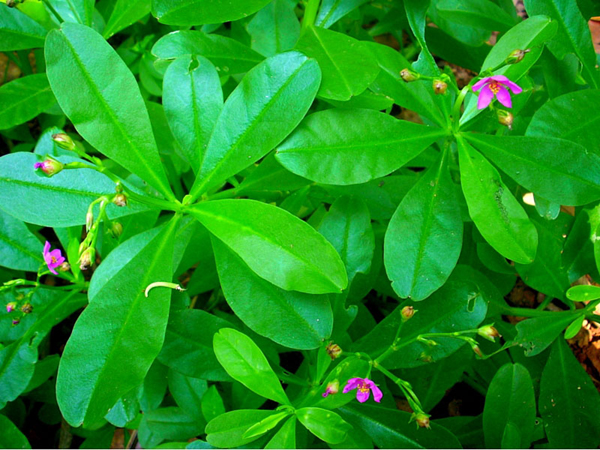
The writer By Prof. Raphael Nyarkotey Obu
Waterleaf (Talinum triangulare) is a leafy vegetable that belongs to the Portulacaceae family. It is native to tropical Africa and has many traditional uses. The leaves and stems of the waterleaf are used as food, while the roots are used for medicinal purposes.
Waterleaf is a perennial vegetable that grows naturally in Mexico, the Caribbean, West Africa, Central America, and South America. It is cultivated as a leafy vegetable in the tropics. It is a vegetable called by many names; including Ceylon Spinach, Yoruba – Gubre, Philippine Spinach, Potherb Fameflower, Lagos Bologi, Sweetheart, Ghanaian Kutu Bataw, Florida Spinach, Sriname purslane, and Cariru.
Water leaves are crispy, flavourful, and nutritious, and these plants grow upright and reach heights of 30 cm to 100 cm (12 to 39 inches), sometimes up to 5 feet, according to some reports. Waterleaf also has a succulent, fleshy texture and a slightly bitter taste. The leaves are dark green and have a broadly triangular shape. The plant grows and produces small, pink, and white flowers.
Waterleaf is a rich source of vitamins and minerals, including vitamins A, C, and K, as well as calcium, iron, and magnesium. It is also a good source of dietary fiber and is an excellent source of vitamins C and A, iron, zinc, and molybdenum. This leafy green vegetable has a high water content, which makes it very refreshing and hydrating.
Nutrition
Webmd.com explained that waterleaf is a rich source of the essential nutrients Calcium, Phosphorus, Iron, and Vitamin C.
It is also a good source of:
Vitamin A
Thiamine
Riboflavin
Niacin
Nutrients per Serving
Every 100 grams of waterleaf contains approximately:
Calories: 25
Protein: 2.4 grams
Fat: 0.4 grams
Carbohydrates: 4.4 grams
Fiber: 1.0 grams
Ezekwe et al., (2001), also found that it is rich in vitamin E, Omega-3 fatty acids, calcium, magnesium, soluble fibers (pectin), potassium, β-carotene, proteins, and dietary fiber. Additionally, Enete and Okon (2010) found that waterleaf is a rich source of crude protein (22.1%), crude fiber (11.12%), and ash (33.98%). All these vitamins and minerals contribute to the high antioxidant values of waterleaf.
Waterleaf, Science

Medicinal Properties
One study by Aja et al., (2010) found that waterleaf is an excellent source of tannins, alkaloids, saponins, and flavonoids. Hence, it has good medicinal and dietary benefits.
Antioxidant
Farombi and Fakoya, (2005) study revealed that antioxidants also help to prevent and minimize the reactive effects of free radicals, including oxidative damage to membranes and increased enzyme inactivation or susceptibility to lipid peroxidation.
Due to this, Liang et al., (2011) intro study of waterleaf established diverse antioxidant activities in this leaf. Hence, consuming waterleaf could help you fight free radicals, thus preventing aging as well.
Liver support
Studies have demonstrated the potential benefits of consuming waterleaf in treating liver diseases by lowering the concentration of the enzymes in the blood. One study by Ezekwe et al., (2013) found the leaves to contain bioactive compounds and can be used to treat liver diseases. A previous study by Liang et al., (2011) also found that waterleaf can be used to manage liver diseases.
Improves Anemia
Ezekwe et al., (2013) recommended that waterleaf should be part of pregnant women’s diet as the vegetable helps to prevent anemia as well as boosts the blood level. This is because the plant can clear bilirubin from the blood, which suggests that it can help the red cells to remain longer and be effectively utilized by the body.
Improves Memory
One study by Ofusori et al., (2008) examined waterleaf aqueous extract on brain function of mice and found that it can improve brain health. These researchers recommend the need for regular intake of waterleaf as it supports the neurons of the cerebrum and enhances cerebral functioning.
Fight Constipation
Waterleaf has abundant dietary fiber. Hence, it improves constipation. Proper food digestion is essential for preventing gastrointestinal disorders such as indigestion, constipation, flatulence, and irritable bowel syndrome (IBS). Additionally, it is a good source of a natural laxative.
Blood Sugar Level
For those battling blood sugar, one study by Joshua et al., (2012) found that waterleaf should be part of your diet as it helps to manage your sugar level. After any meal, you can drink the juice or the tea form as well, as the high dietary contents of this vegetable help to slow down the digestion and conversion of starch to simple sugars. This process helps in managing diabetes.
Cholesterol Level
Joshua et al., (2012) study further revealed that waterleaf is paramount in helping to control cholesterol levels. It does this by using the high dietary fiber content to reduce the absorption of cholesterol from the gut thereby protecting the body from any sicknesses associated with bad cholesterol in the body.
Prevents Cancer
Due to the high antioxidant found in waterleaf, studies reveal that it is suitable for preventing the onset of cancer and tumourgrowths. Waterleaf has chemopreventive activity against colon and breast cancers due to its squalene content (Kristine et al. 2015).
High Blood Pressure
Uncontrolled high blood pressure could lead to stroke and many others. However, one study by Adewunmi et al., (1980) found that waterleaf can be useful for preventing the onset of cardiovascular diseases such as stroke. Also, leaf and root extracts are used for treating asthma, fresh cuts, scabies, anemia, and high blood pressure (hypertension) (Ogunlesi et al. 2010).
Weight Management
Mensah et al., (2008) reveal that the high dietary fiber in waterleaf provides bulk in the diet thus minimizing the intake of starchy foods. This helps to prevent obesity and excess body weight.
Poultry Feed
Farmers can also use waterleaf as animal feed. Nworgu et al., (2015) study found that using water-leaf meal is a good source of supplements for poultry. Their result shows that waterleaf meal is an ideal protein supplement for broilers, especially for broiler finishers without any detrimental effects on their performance.
Waterleaf can be used as forage for rabbits (Enete and Okon2010). A component of the plant extract in drinking water boosts the immune response of broiler chicks against the virulent Newcastle disease virus (Sanda 2015). Waterleaf extract serves as an inhibitor of mild steel corrosion in an acidic medium (Ajiwe and Ejike 2020).
Protect the environment
Waterleaf can also be used for ornamental purposes in urban and peri-urban spaces for urban greening and environmental protection (Satterthwaite et al. 2010). Additionally, waterleaf is used in bioremediation for accumulating heavy metals from soil exposed to anthropogenic activities (Anyalogbu et al. 2017). This crop also helps in minimizing the impact of soil erosion.
Skin health
The leaves are used to treat several diseases, including measles (Oluwole et al. 2003).
Waterleaf Juice
Most people may not be versatile with waterleaf juice as it is mainly used in cooking, serving as an important vegetable in many local cuisines in Nigeria. The juice of waterleaf is very beneficial to health and is effective in increasing the blood level and treating many health conditions that have proven successful.
To get the juice;
Wash the waterleaf thoroughly to remove dirt and sand impurities.
Don’t pluck the leaves from the stem, as both are medicinal and contain various nutrients.
Cut it into tiny pieces to enable easy squeezing or pounding.
Then squeeze effectively and strain the juice.
Alternatively, some grinding machines like a blender can do this work, but the above method should be considered if there is none.
Is Waterleaf Good in Pregnancy?
Waterleaf is often called the “blood-pumping machine” as it plays a vital role in the adequate production of blood in the human body.
It is suitable for pregnant women as it helps increase their blood levels and supply them with other vital nutrients that the body needs.
Side Effects
Though it has many benefits, it should be limited to people suffering from kidney disorders and gout due to its oxalate content. When cooked, oxalates are reduced by 50% and nitrates and nitrites (Willie and Eze 2016) reduce to negligible levels (Agunbiade et al. 2015).
Also, when it is eaten in excess, it can cause stomach upset and frequent stooling.
Waterleaf should not be incorporated into infant meals because of the antinutrients in it (Schippers 2000).
NB:
Prof. Nyarkotey has strict sourcing guidelines and relies on peer-reviewed studies, academic research institutions, and medical associations to justify his write-ups.
My articles are for educational purposes and do not serve as Medical advice for Treatment and diagnosis. Hence, does not create any patient-physician relationship. I aim to educate the public about evidence-based scientific Naturopathic Therapies. Remember to always consult your healthcare provider before making any health-related decisions or for counseling, guidance, and treatment about a specific medical condition.
The writer is a Professor of Naturopathic Healthcare, a Medical Journalist, and a science writer. President, NyarkoteyUniversity College of Holistic Medicine & Technology (NUCHMT)/African Naturopathic Foundation, Ashaiman, Ghana. Currently BL Candidate at the Gambia Law School, Banjul, Gambia. E. mail: professor40naturopathy@gmail.com.
References
1. Nworgu, F. C., Alikwe, P. C. N., Egbunike, G. N. and Ohimain, E. I. (2015), Economic Importance and Growth Rate of Broiler Chickens Fed with Water Leaf (Talinumtriangulare) Meal Supplements, Asian Journal of Agricultural Extension, Economics & Sociology 4(1): pp. 49-57.
2. Liang D, Zhou Q, Gong W, Wang Y, Nie Z, He H, Li J, Wu J, Wu C, Zhang J. (2011), Studies on the antioxidant and hepatoprotective activities of polysaccharides from Talinum triangulare. Journal of
Ethnopharmacol; 136(2): pp. 316–321.
3. Joshua Z. P., Timothy A. G. and Suleiman M. M. (2012), The effect of cooking time on the vitamin C, dietary fiber and mineral compositions of some local vegetables, Science World Journal;7(1): pp. 29-30.
4. Ezekwe, C. I., Chidinma, R. U. and Okechukwu, P. C. U. (2013), The Effect of Methanol Extract of Talinum Triangulare (Water Leaf) on the Hematology and Some Liver Parameters of Experimental Rats, Global Journal of Biotechnology & Biochemistry 8 (2): pp. 51-60.
5. Ezekwe, M. O, Besong S. A. and Igbokwe P. E. (2001), Beneficial influence of purslane and waterleaf
supplement to Humans. FASEB Journal;16:A639.
6. Mensah J. K., Okoli R. I., Ohaju-Obodo J. O. and EifediyiK. (2008), Phytochemical, nutritional and medical properties of some leafy vegetables consumed by Edo people of Nigeria. African Journal of Biotechnology, vol. 7(14): pp. 2304-2309.
7. Ofusori, D. A., Adelakun, A. E., Ayoka, A. O., Oluwayinka, O. P., Omotoso, E. O., Odukoya, S. A. and Adeyemi, D. O. (2008), Waterleaf (Talinum triangulare) Enhances Cerebral Functions in Swiss albino mice, Journal of Neurological Sciences [Turkish] 25:(4) 17; pp. 239-246.
8. Adewunmi A. O. and Sofowora E. A. (1980), Preliminary screening of some plant extracts for molluscidal activity. Planta med; 39:57-82.
9. Kristine, B., S. Chien-Chang, and R. Consolacion. 2015. “Chemical Constituents of Talinum triangulare.” Research Journal of Pharmaceutical, Biological and Chemical Sciences 6 (1): 167–171.
10. Sanda, M. E. 2015. “Effects of Waterleaf (Talinumtriangulare) Extract on Performance and Immune Response of Broilers Vaccinated with Newcastle Disease Vaccine (LaSota).” International Journal of Food, Agriculture and Veterinary Sciences 5 (2): 60–63.
11. Enete, A. A., and U. E. Okon. 2010. “Economics of Waterleaf (Talinum triangulare) Production in Akwa Ibom State, Nigeria.” Field Actions Science Reports 4:1–5. http://journals.org/factsreports/438
12. Ogunlesi, M., W. Okiei, L. Azeez, V. Obakachi, M. Osunsanmi, and G. Nkenchor. 2010. “Vitamin C Contents of Tropical Vegetables and Foods Determined by Voltammetric and Titrimetric Methods and Their Relevance to the Medicinal Uses of the Plants.” International Journal of Electrochemical Sciences 5:105–115.
13. Oluwole, F. S., A. O. Falade, and O. O. Ogundipe. 2003. “Anti-inflammatory Effect of Some Common Nigerian Vegetables.” Nig. J. Physiol. Sci. 18 (1): 35–38. https://doi.org/10.4314/njps.v18i1.32616
14. Satterthwaite, D., G. McGranahan, and C. Tacoli. 2010. “Urbanization and Its Implications for Food and Farming.” Philosophical Transactions of the Royal Society B 365 (1554): 2809–2820. https://doi.org/10.1098/rstb.2010.0136
15. Ajiwe, V. I. E., and C. E. Ejike. 2020. “Talinumtriangulare (Waterleaf) Methanol Leaf Extract as Corrosion Inhibitor on Mild Steel Surface in H2SO4.” Colloid and Surface Science 5 (1): 6–12. https://doi.org/10.11648/j.css.20200501.12
16. Anyalogbu, E. A. A., C. C. Anadi, P. C. Nwweje-Anyalowu, and M. C. Nnoli. 2017. “Use of Waterleaf (Talium triangulare) in Remediation of Soil Exposed to Heavy Metals: A Green Technology Approach.” World Journal of Pharmaceutical and Life Sciences 3 (9): 48–53.





